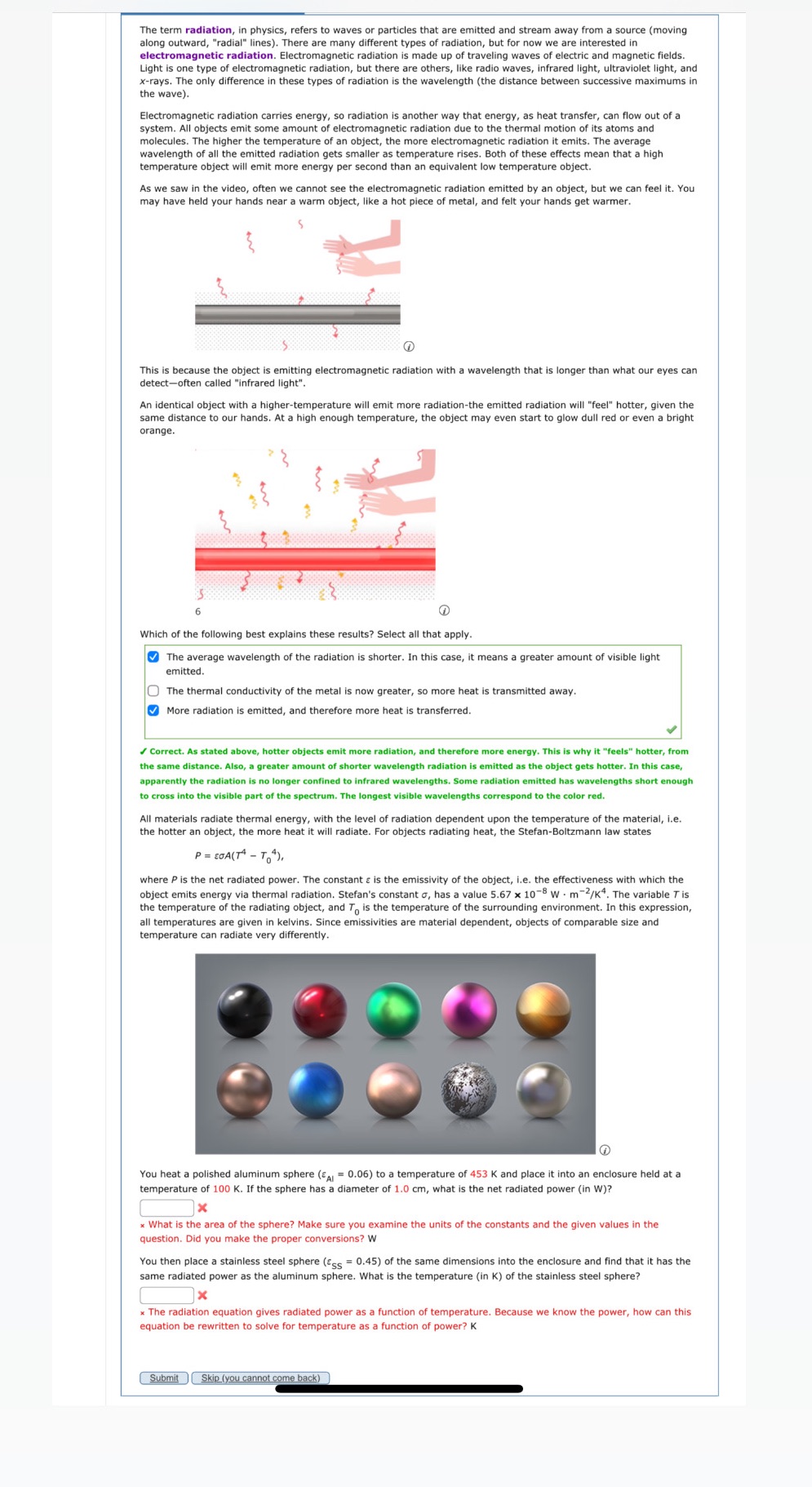I need help please and thank you !
The term radiation, in physics, refers to waves or particles that are emitted and stream away from a source (moving along outward, "radial\" lines). There are many different types of radiation, but for now we are interested in electromagnetic radiation. Electromagnetic radiation is made up of traveling waves of electric and magnetic fields. Light is one type of electromagnetic radiation, but there are others, like radio waves, infrared light, ultraviolet light, and x-rays. The only difference in these types of radiation is the wavelength (the distance between successive maximums in the wave). Electromagnetic radiation carries energy, so radiation is another way that energy, as heat transfer, can flow out of a system. All objects emit some amount of electromagnetic radiation due to the thermal mation of its atoms and malecules. The higher the temperature of an object, the more electromagnetic radiation it emits. The average wavelength of all the emitted radiation gets smaller as temperature rises. Both of these effects mean that a high temperature object will emit more energy per second than an equivalent low temperature object. As we saw in the video, often we cannot see the electromagnetic radiation emitted by an object, but we can feel it. You may have held your hands near a warm object, like a hot piece of metal, and felt your hands get warmer. S iz, 5 @ This is because the object is emitting electromagnetic radiation with a wavelength that is longer than what our eyes can detectoften called "infrared light". An identical object with a higher-temperature will emit more radiation-the emitted radiation will "feel" hotter, given the same distance to our hands. At a high enough temperature, the cbject may even start to glow dull red or even a bright orange. 3 ; 1] 5 : 2 6 @ Which of the following best explains these results? Select all that apply. The average wavelength of the radiation is shorter. In this case, it means a greater amount of visible light emitted. () The thermal conductivity of the metal is now greater, so more heat is transmitted away. More radiation is emitted, and therefore more heat is transferred. J # Correct. As stated above, hotter objects emit more radiation, and therefore more energy. This is why it "feels\" hotter, from the same distance, Also, a greater amount of shorter wavelength radiation is emitted as the object gets hotter. In this case, apparently the radiation is no longer confined to infrared wavelengths. Some radiation emitted has wavelengths short enough to cross into the visible part of the spectrum. The longest visible wavelengths correspond to the color red. All materials radiate thermal energy, with the level of radiation dependent upon the temperature of the material, i.e. the hotter an object, the more heat it will radiate. For objects radiating heat, the Stefan-Boltzmann law states P=eoA(T* - T, where P is the net radiated power. The constant is the emissivity of the object, i.e. the effectiveness with which the object emits energy via thermal radiation. Stefan's constant o, has a value 5.67 x 1078 W - m /K%, The variable T is the temperature of the radiating object, and To is the temperature of the surrounding environment. In this expression, all temperatures are given in kelvins. Since emissivities are material dependent, objects of comparable size and temperature can radiate very differently. You heat a polished aluminum sphere (EN = 0.06) to a temperature of 453 K and place it into an enclosure held at a temperature of 100 K. If the sphere has a diameter of 1.0 cm, what is the net radiated power (in W)? x What is the area of the sphere? Make sure you examine the units of the constants and the given values in the question. Did you make the proper conversions? W You then place a stainless steel sphere (:55 = 0.45) of the same dimensions into the enclosure and find that it has the same radiated power as the aluminum sphere. What is the temperature (in K) of the stainless steel sphere? x = The radiation equation gives radiated power as a function of temperature. Because we know the power, how can this equation be rewritten to solve for temperature as a function of power? K %







